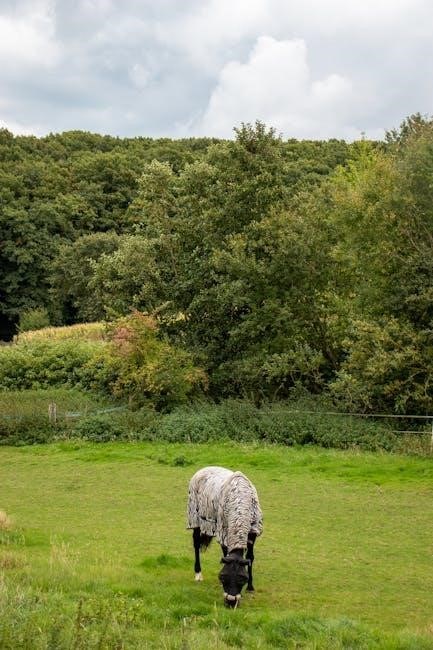Welcome to the Canon EOS R100 Manual, your comprehensive guide to mastering the 24.1MP APS-C mirrorless camera. Designed for beginners, it offers RF mount compatibility and intuitive controls.

Overview of the Canon EOS R100 Camera
The Canon EOS R100 is an entry-level APS-C mirrorless camera designed for beginners, offering a 24.1MP sensor and RF mount compatibility. Lightweight and compact, it measures 3.4 x 4.6 x 2.7 inches and weighs 12.6 ounces, making it portable for everyday use. As the youngest model in Canon’s EOS R lineup, it provides an affordable entry into the mirrorless ecosystem, replacing entry-level DSLRs like the Rebel SL2 and T7. Its streamlined design focuses on essential features, ensuring ease of use while delivering quality images and flexibility beyond smartphones.
Purpose and Scope of the Manual
This manual is designed to unlock the full potential of your Canon EOS R100, providing a detailed guide for setup, operation, and maintenance. It covers basic and advanced features, ensuring users can navigate the camera’s capabilities seamlessly. Whether you’re a novice or seeking to enhance your photography skills, this manual offers comprehensive instructions to optimize your shooting experience. It includes troubleshooting tips, customization options, and best practices for capturing stunning images, helping you make the most of your EOS R100.
Key Features of the Canon EOS R100
The Canon EOS R100 boasts a 24.2MP APS-C CMOS sensor and DIGIC 8 image processor for crisp, high-quality images. It features 4K video recording at 30fps and Full HD at 120fps, perfect for dynamic content creation. The camera includes Dual Pixel AF for fast and precise autofocus, with eye and face detection for portraits. Wi-Fi and Bluetooth connectivity enable easy file transfer and remote shooting. Its vari-angle touchscreen LCD and lightweight design make it versatile for various shooting scenarios, catering to both beginners and advanced photographers seeking portability and performance.

Technical Specifications of the Canon EOS R100
The Canon EOS R100 features a 24.2MP APS-C CMOS sensor, DIGIC 8 processor, weighing 445g, with LP-E17 battery support and SD/SDHC/SDXC card compatibility.
Image Sensor and Processor Details
The Canon EOS R100 is equipped with a 24.2-megapixel APS-C CMOS sensor, delivering sharp and detailed images. Paired with the DIGIC 8 image processor, it ensures fast operation, accurate color reproduction, and reduced noise. This combination enhances dynamic range and supports advanced autofocus and metering systems, making it ideal for both stills and video. The sensor’s design optimizes light capture, while the processor accelerates tasks like RAW processing and burst shooting, providing a seamless photography experience for enthusiasts and professionals alike.
Lens Compatibility and Mount Type
Lens Compatibility and Mount Type
The Canon EOS R100 utilizes the RF mount, designed for compatibility with Canon’s RF lenses. This mount offers enhanced communication speed and optical performance. It is also backward-compatible with EF and EF-S lenses when using the EF-EOS R adapter, providing access to a wide range of lenses. The RF mount’s compact design allows for innovative lens designs, while maintaining compatibility with existing Canon optics, ensuring versatility for photographers. This flexibility makes the EOS R100 adaptable to various shooting needs, from wide-angle to telephoto photography.
Resolution and ISO Range
The Canon EOS R100 features a 24.2-megapixel APS-C CMOS sensor, delivering crisp and detailed images. It supports a standard ISO range of 100-51200, extendable to 102400 for low-light conditions. This flexibility ensures optimal performance in various lighting environments. The camera’s DIGIC X image processor enhances noise reduction, maintaining image quality even at higher ISO settings. These specifications make the EOS R100 suitable for capturing sharp, vibrant photos, whether in bright daylight or dimly lit scenes, catering to both casual and advanced photographers.
Autofocus and Metering Systems
The Canon EOS R100 boasts an advanced Dual Pixel CMOS AF system, offering precise and rapid autofocus performance. It features 4,800 selectable AF points, ensuring sharp focus even in challenging lighting conditions. The camera supports Eye AF and Face Detection, ideal for portraits. For metering, it utilizes a 384-zone Evaluative metering system, along with Center-Weighted, Spot, and Partial modes, providing accurate exposure control. The DIGIC X processor enhances autofocus speed and metering precision, making it versatile for various shooting scenarios.

Getting Started with the Canon EOS R100
Unbox and set up your camera, charge the battery, insert a memory card, and attach lenses. Familiarize yourself with controls and basic settings for photography.
Unboxing and Initial Setup
Upon unboxing the Canon EOS R100, you’ll find the camera body, EF-M lens, battery, charger, shoulder strap, and user manual. Carefully handle the camera, ensuring the sensor and lens are clean. Place the camera on a stable surface and avoid touching the image sensor. Insert the battery and ensure it’s fully charged before use. Familiarize yourself with the camera’s buttons, dials, and ports. Check for any firmware updates via the Canon website to ensure optimal performance. Follow the manual’s setup guide for initial configurations, such as setting the date, time, and language. This initial setup ensures a smooth start to your photography journey.
Charging the Battery and Power Management
Always use the provided LC-E12 charger to charge the LP-E12 battery. Ensure the battery is fully charged before first use. The charging indicator will turn green when complete, typically taking about 2 hours. Avoid overcharging, as it may reduce battery lifespan. Use only Canon-approved accessories to prevent damage. Turn off the camera when not in use to conserve power. Enable Eco Mode in the menu to extend battery life. Monitor the battery level icon on the LCD screen and recharge when it reaches 6% or below. Replace the battery if it no longer holds a full charge after extended use.
Memory Card Installation and Formatting
Insert a compatible SD, SDHC, or SDXC memory card into the camera’s card slot, located on the right side. Ensure the card is properly seated and the write-protect tab is not engaged. Format the card using the camera’s menu to optimize performance. Go to Menu > Settings > Format Card and confirm the action. Note that formatting will erase all data on the card. Always format cards in the camera, not on a computer, to avoid compatibility issues. Use a high-speed card for best performance, especially when shooting video or in burst mode.
Attaching Lenses and Accessories

To attach a lens, align the RF mount on the camera with the lens mount, ensuring the white dot on the lens aligns with the dot on the camera. Gently twist the lens clockwise until it clicks into place. For EF/EF-S lenses, use the Canon EF-EOS R mount adapter. Attach accessories like the EF-EOS R adapter or extension tubes to the lens mount before adding the lens. Ensure only one accessory is attached at a time. Always handle lenses and accessories with care to avoid damage or scratches to the mount or glass elements.
Shooting Modes and Settings
The Canon EOS R100 offers various shooting modes, including Basic Zone modes like Scene Intelligent Auto and Creative Zone modes such as Manual, Aperture Priority, and Shutter Priority. Custom modes C1, C2, and C3 allow personal settings storage for quick access, enhancing shooting efficiency and creativity.
Basic Zone Modes (Scene Intelligent Auto, etc.)
The Canon EOS R100’s Basic Zone modes simplify photography by automating settings for specific scenarios. Scene Intelligent Auto mode analyzes the scene and adjusts settings for optimal results. Portrait mode emphasizes subject details with a blurred background, while Landscape mode sharpens distant objects. Close-up mode captures fine textures in macro shots, and Action mode freezes fast-moving subjects. Night Portrait mode balances subject and background lighting in low-light conditions, ensuring vibrant and clear images in various lighting conditions without manual adjustments.
Creative Zone Modes (Manual, Aperture Priority, etc.)
The Canon EOS R100’s Creative Zone modes offer advanced control for photographers. Manual (M) mode allows full control over aperture and shutter speed. Aperture Priority (Av) lets you set the f-stop, with the camera adjusting shutter speed. Shutter Priority (Tv) mode enables control over shutter speed for motion effects. Program (P) mode provides flexibility while the camera adjusts settings. These modes empower users to tailor exposure settings to their creative vision, offering precise control over lighting, depth of field, and motion capture for professional-grade results.
Custom Shooting Modes (C1, C2, C3)
The Canon EOS R100’s Custom Shooting Modes (C1, C2, C3) allow users to save personalized settings for quick access. These modes store combinations of shooting parameters like exposure, autofocus, and white balance. To register settings, navigate to the Menu, select Custom Shooting Mode, and choose Register. Once saved, modes can be accessed via the Mode Dial or Quick Control Screen. This feature streamlines workflows for specific shooting scenarios, enabling rapid adjustments and enhancing productivity during photography sessions.

Focus and Exposure Control
The Canon EOS R100 offers precise focus and exposure control, ensuring sharp images and accurate lighting. Its advanced autofocus and exposure systems cater to various photography needs.
Autofocus Modes and Customization
The Canon EOS R100 features advanced autofocus modes, including Face and Eye Detection, Subject Tracking, and Spot AF. Users can customize AF settings, such as tracking sensitivity and AF priority, to suit their needs. The camera also supports custom button assignments for AF functions, allowing for personalized control. Additionally, focus peaking is available for manual focus assistance. These options ensure precise and adaptable focusing, enhancing creativity and efficiency in various shooting scenarios.
Manual Focus and Focus Assist Tools
The Canon EOS R100 offers precise manual focus control via the lens focus ring. Enhanced focus assist tools include Focus Peaking, which highlights in-focus areas, and Magnify, enabling up to 10x zoom for accurate focusing. Users can customize these tools, such as adjusting peaking color and magnification location, to streamline their workflow and ensure sharp results in manual focus mode.
ISO Settings and Noise Reduction
The Canon EOS R100 offers an ISO range of 100-51200, extendable to 100-102400 for improved low-light performance. Noise reduction tools include Automatic Noise Reduction and High ISO Speed Noise Reduction, which minimize grain in high-sensitivity images. Users can adjust noise reduction levels or disable it for RAW shooting. Additionally, the Multi-Shot Noise Reduction feature combines multiple images to reduce noise effectively, ensuring cleaner results in challenging lighting conditions while maintaining image quality.
Metering Modes and Exposure Compensation
The Canon EOS R100 features four metering modes: Evaluative, Center-Weighted, Spot, and Average. Evaluative metering analyzes the entire scene for balanced exposure, while Center-Weighted prioritizes the center. Spot metering measures light from a specific area, ideal for challenging lighting. Exposure compensation allows adjustments of +/-3 stops in 1/3-stop increments, enabling fine-tuning of brightness. This feature is accessible via the Quick Control Dial or dedicated buttons, ensuring precise control over exposure in various shooting conditions.

Image Quality and Output Settings
The Canon EOS R100 supports JPEG, RAW, and HEIF file formats. It offers image compression and resolution options for optimal quality and storage. Custom Picture Styles and color spaces are available. Adjust noise reduction and sharpening settings to refine output.
File Formats (JPEG, RAW, HEIF)
The Canon EOS R100 supports three primary file formats: JPEG, RAW, and HEIF. JPEG is ideal for everyday shooting, offering compressed files with efficient storage. RAW files capture maximum image data, enabling advanced post-processing. HEIF provides higher quality and smaller file sizes compared to JPEG. Each format caters to different needs, from sharing-ready images to professional-grade editing. The camera allows simultaneous RAW+JPEG recording for flexibility. Choose the format that best suits your workflow and creative goals.
Image Compression and Resolution Options

The Canon EOS R100 offers versatile image compression and resolution options to suit various needs. It supports multiple JPEG compression levels, including Fine and Standard, allowing users to balance file size and quality. The camera also features scalable resolution options, enabling photographers to shoot at different aspect ratios or reduce file sizes for sharing. Additionally, the R100 provides in-camera image scaling, letting you resize images without a computer. These options ensure flexibility for both professional workflows and casual shooters, optimizing storage and efficiency while maintaining image integrity.
Picture Styles and Customization
The Canon EOS R100 allows for extensive customization of Picture Styles, enabling photographers to tailor images to their creative vision. Predefined styles like Auto, Standard, Portrait, Landscape, and more provide distinct looks. Users can adjust settings such as sharpness, contrast, and color tone within each style. Additionally, you can create and save up to three Custom Picture Styles, ensuring consistent results across shoots. This feature is ideal for achieving a personalized aesthetic without post-processing, making it a powerful tool for both enthusiasts and professionals.
White Balance and Color Temperature
The Canon EOS R100 offers precise control over White Balance and Color Temperature to ensure accurate color reproduction. Users can select from options like Auto, Daylight, Shade, Tungsten, Fluorescent, and Custom. The Color Temperature setting allows manual adjustment between 2,500K to 10,000K for tailored results. This feature is essential for capturing natural hues under various lighting conditions, ensuring images reflect the intended mood and atmosphere. Customizing White Balance enhances creative control, making it ideal for photographers seeking precise color accuracy and consistency in their work.
Video Recording and Playback
The Canon EOS R100 supports 4K video at 30p and Full HD at 60p. It features Movie Digital IS for stabilization, smooth autofocus, and HDR options. Playback allows editing and slow-motion.
Video Shooting Modes and Settings
The Canon EOS R100 offers versatile video shooting modes, including Manual, Aperture Priority, and Program AE. Users can shoot in 4K at 30p or Full HD at 60p, with options for time-lapse and HDR recording. Settings like frame rates, resolution, and compression can be adjusted for customized video output. The camera also supports digital stabilization and audio level adjustments for enhanced video quality. Additionally, the touchscreen enables smooth focus transitions and mode switching during recording, ensuring professional-grade results for creators.
Autofocus and Stabilization in Video
The Canon EOS R100 features advanced autofocus capabilities during video recording, utilizing its Dual Pixel AF system for smooth and precise subject tracking. The camera supports face and eye detection, as well as subject detection for animals and objects, ensuring sharp focus even in dynamic scenes. Additionally, the EOS R100 offers enhanced electronic image stabilization, reducing camera shake and blur in handheld recordings. Customizable AF sensitivity and speed settings allow users to tailor focus transitions to their creative needs, while the Movie Servo AF2 mode provides quiet and continuous focusing during video capture.
Playback Options and Editing Features
The Canon EOS R100 offers comprehensive playback options, including image review, video playback, and histogram display for exposure assessment. Users can edit photos in-camera with tools like cropping, aspect ratio adjustment, and filters. Videos can be trimmed or rated directly on the camera. The EOS R100 supports 4K resolution playback, ensuring detailed review of footage. While in-camera editing is convenient, for advanced post-processing, transferring files to a computer is recommended for greater control over image and video manipulation.
Customization and Advanced Features
The Canon EOS R100 allows users to customize buttons, dials, and the My Menu tab for streamlined workflows. Advanced features like customizable controls enhance shooting efficiency and personalization.
Customizing Buttons and Dials
The Canon EOS R100 offers extensive customization options for buttons and dials, allowing users to tailor controls to their preferences. The M-Fn button, for instance, can be assigned to frequently used functions like ISO or AF modes. The control ring on RF lenses can also be customized to adjust settings such as aperture or exposure compensation. These customization options enhance shooting efficiency and streamline workflows, making the camera more intuitive to use. Users can save their preferred setups for quick access, ensuring a personalized and efficient shooting experience every time.
Using the My Menu Tab
The My Menu Tab on the Canon EOS R100 allows users to organize their most frequently accessed settings for quick and easy access. This feature streamlines workflows by letting you register up to six functions or menu items. To use it, navigate to the menu, select “My Menu Tab,” and choose the functions you want to add. You can then arrange these items in any order. The My Menu Tab is accessible during both shooting and playback, making it a time-saving tool for personalizing your camera experience and enhancing efficiency.
Updating Firmware and Software
Regularly updating the Canon EOS R100’s firmware and software ensures optimal performance and access to the latest features. To update, visit the official Canon website, download the newest firmware version, and follow the installation instructions. Use a memory card or connect the camera to a computer via USB. During the update, avoid interrupting the process to prevent damage. Always verify the firmware version after installation to confirm success. Keeping your camera up-to-date guarantees improved functionality, compatibility, and enhanced user experience.

Maintenance and Troubleshooting
Regular maintenance ensures the Canon EOS R100’s longevity. Clean the sensor and lens, check for firmware updates, and address common issues promptly to maintain performance and reliability.
Cleaning the Camera and Lens
Regular cleaning is essential to maintain the Canon EOS R100’s performance. Use a soft, dry microfiber cloth to wipe the camera body and lens surfaces. For stubborn smudges, lightly dampen the cloth with water, but avoid harsh chemicals. To clean the sensor, use a hand-operated air blower to gently remove dust particles. Always handle the lens with clean hands and store it with a protective cap to prevent scratches and contamination. Avoid touching the sensor directly to prevent damage or smudging.
Common Issues and Solutions
Common issues with the Canon EOS R100 include poor battery life, blurry images, or camera not turning on. For battery life, ensure power-saving features are enabled. Blurry images may result from incorrect autofocus settings or dirty lenses—clean the lens and reset autofocus. If the camera won’t power on, check the battery or charging port; Connectivity issues with smartphones can be resolved by resetting network settings or updating the Canon app. For persistent problems, consult the manual or contact Canon support for assistance.
Resetting the Camera to Factory Settings
To reset the Canon EOS R100 to factory settings, go to the Menu and navigate to the Setup tab. Select Clear Settings and choose Reset Camera Settings. Confirm by selecting OK. This restores default settings, erasing custom configurations. Note that this doesn’t format the memory card. After resetting, recalibrate your preferred settings for optimal performance. This process is useful for troubleshooting or preparing the camera for resale.
Tip: Ensure all important images are backed up before resetting.

Mastering the Canon EOS R100 unlocks endless creative possibilities. Explore its features, practice techniques, and refer to resources for continuous improvement. Happy shooting!
Final Tips for Mastering the Canon EOS R100
- Experiment with different shooting modes to understand their strengths.
- Practice regularly to become familiar with the camera’s settings and controls.
- Update firmware periodically to access new features and improvements.
- Organize your files and backups to ensure your work is safe.
- Explore autofocus and metering systems for precise control.
- Customize buttons and save favorite settings for quick access.
- Join photography communities to share ideas and learn from others.
- Balance technical skills with creativity to capture stunning images.
Resources for Further Learning
Expand your skills with official Canon resources, including the EOS R100 manual and online tutorials. Visit Canon’s website for detailed guides, firmware updates, and troubleshooting tips. Explore YouTube channels and photography forums for user-generated content and tips. Enroll in photography workshops or online courses to master advanced techniques. Join Canon user groups to connect with fellow photographers and share experiences. Regularly check Canon’s support page for software updates and new features. Utilize the Canon EOS R100’s built-in help menu for quick guidance on specific functions.
